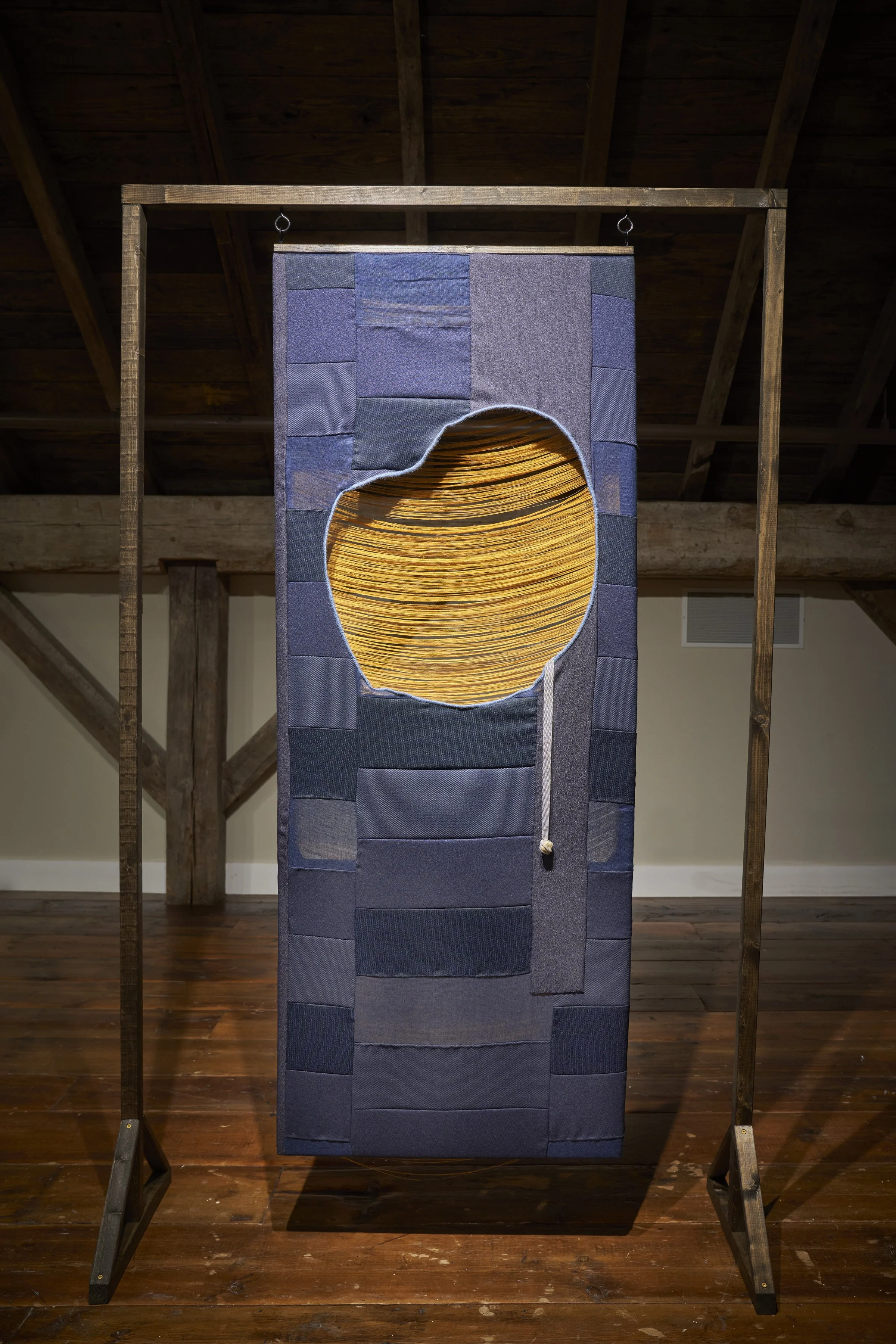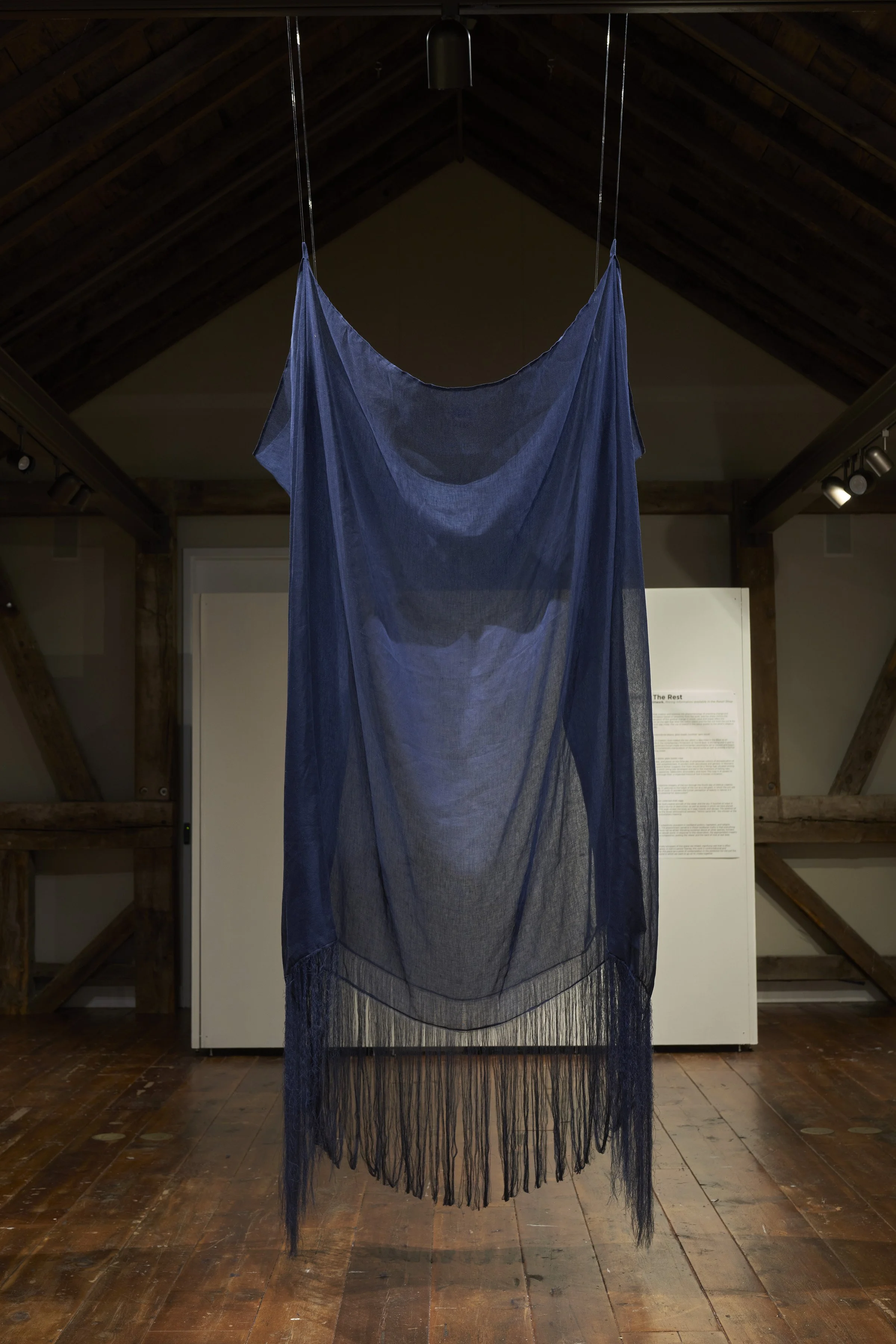The Ravel & The Rest
Solo Exhibition at The Bascom
in conjunction with the Winter Artist Resident Program
January - April 2023
The Ravel & The Rest is an exhibition of ironic abstraction, juxtaposing gestures towards creation myths and contemporary existential concerns surrounding climate change, globalization, and technological advances. Textiles serve as a metaphor for human production at large, and this notion of “the ravel”, a loose thread that’s been parsed, speaks to this enigmatic zeitgeist periphery - straddling between states of becoming and the process of unmaking. Referencing the perceived binary of hand and machine, good and evil, salvageable and too far gone, The Ravel & The Rest is simultaneously a space of rest from, and an incubator of contemplation for, this world we’ve made.
I
Collected cotton + linen, alpaca, bleach
I (detail)
I represents the first day of Christian biblical creation and explores the phenomenology of unending change and inner illumination. Shift in value affects perception based on proximity from the work, and the shape mimics the human body, implicating the viewer. Observation of this gradual change in woven value and shape offers the examination of oneself, as well as reflection on the light that drew the cotton plants and the flax out from the soil & the plants that fed the alpaca by which this work was made. The use of bleach in this piece speaks to the artist’s religious upbringing, simultaneously pure and caustic.
II
Collected upholstery fabric, linen, hand embroidered alpaca, glass beads, tumbled "gem stone"
II (detail)
According to Genesis, on the second day of creation, God created the sky, which is described in the Bible as an “expanse”, “vault”, or “firmament”. The hole in the contemporary firmament, or Ozone layer, is shrinking and is said to be restored by 2066 - perhaps the most significant human-made environmental catastrophe we’ve caused and begun to rectify. The glass beads and rock refer to humankind’s manipulation of the natural world as well as provide a formal juxtaposition of harnessing and relinquishing power.
III
Collected upholstery fabric, linen, selvedge denim, glass beads, rope
III (detail)
Scripture states that God made dry land, seas, and plants on the third day. III emphasizes notions of domestication of the natural world. Juxtaposing barrenness with embellishment, III ponders both apocalypse and genesis. In Women’s Work: The First 20,000 Years, Elizabeth Wayland Barber suggests that there should be a ‘String Age’ situated among the Stone Age, Iron Age, and Bronze Age, in which string was developed and led to the inventions of fishing nets, rope, weaving, clothes, ritual cloth, blankets, tapestries, tablecloths, embroidery, and more. The rope in III speaks to that human ability to conquer and progress through fiber: a neglected historical tool in human civilization.
IV
Linen, cotton
V
Linen, cotton, bamboo, preserved chicken foot, collected shell, eggs
VI
Collected cotton, linen, and synthetic yarn
VII
Linen
IV (detail)
Evoking compositional binary movement, IV explores imagery of the sun through the fourth day of biblical creation. Whether interpreted as emitting or absorbing, IV gestures to the future of the sun as a red giant, in which the sun will expand, absorbing Earth. A theme in this body of work, IV ponders the human perception of beauty in nature; is it perceived as beautiful only when we forget its potential for destruction?
V (detail)
V (detail)
On the fifth day of creation, scripture says that God created animals of the water and the sky. V touches on ways in which primal textiles can be both a provider and a source of destruction, as well as stories in which we have placed humanity at the center of the natural world. This work evokes the body, as it sags, hoards, and decays. The addition of the chicken foot and egg in this work allude to the Greek philosophical paradox, “Which came first - the chicken or the egg?”, now an unironic cliche devoid of any evolutionary meaning.
VI (detail)
VI is broadly about humanism. The parade of subjectivity prevalent in neoliberal politics, capitalism, and religion places humanity at the center of the universe. The predominant narrative in these neoliberal myths is that everything will turn out the way it should and that we should not be afraid. Elevating ourselves above all other species, humans have crowned ourselves sovereign among the natural world. In response to this observation, the appropriated imagery from “The Creation of Adam” is rotated in the composition, putting the viewer and the hand of God at eye level.
VII (installation view)
The seventh day is the day of rest. VII is an empty occupant of this space we inhabit, signifying rest that is often overlooked in lives driven by capital and progress. A nod to Lenore Tawney, this work is confrontational and empathetic through scale and movement. May this piece be a point of contemplation in the exhibition for not just the world we have made for ourselves, but the world in which we want to go on to create together.





